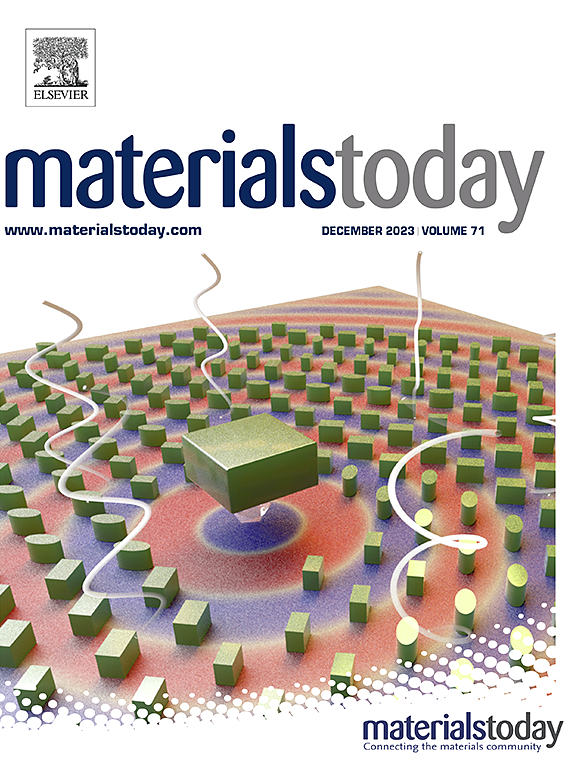新兴的生物医学治疗活性氧和氮调节剂:2D mx酶
IF 21.1
1区 材料科学
Q1 MATERIALS SCIENCE, MULTIDISCIPLINARY
引用次数: 0
摘要
近年来,纳米酶因其在活性氧和活性氮(RONS)调控方面的卓越能力,为活性氧和活性氮相关疾病的治疗提供了有希望的策略,引起了人们的广泛关注。其中,二维mxene纳米酶(2D mx酶)由于其特殊的物理化学性质而成为突出的候选者,包括巨大的比表面积,亲水性,杰出的电学和光学特性,氧化还原反应的优越性能,多功能生物催化,有效的RONS调制以及固有的生物相容性和生物安全性。鉴于人们对合理构建高效、安全的纳米酶的需求日益增长,本文将从二维mx酶的延展性、电学和光学特性、RONS调控机制、内在生物相容性和安全性三个关键方面深入探讨二维mx酶在生物医学领域的应用潜力。我们全面总结和讨论了增强二维mx酶的调控活性策略的最新进展,特别是通过表面修饰、杂交和价态工程。此外,我们强调了这些纳米酶在癌症、抗生素、抗氧化和抗炎治疗中的应用前景。最后,我们讨论了生物医学治疗领域当前面临的挑战和未来的前景,并从代表性研究中得出了见解。本文章由计算机程序翻译,如有差异,请以英文原文为准。

Emerging reactive oxygen and nitrogen species regulators for biomedical therapy: 2D MXenzymes
The burgeoning field of nanozymes has attracted significant attention recently, owing to their remarkable capabilities in modulating reactive oxygen and nitrogen species (RONS), offering promising therapeutic strategies for RONS-related diseases. Among these, two-dimensional MXene-based nanozymes (2D MXenzymes) have emerged as standout candidates due to their exceptional physicochemical properties, including vast specific surface area, hydrophilicity, outstanding electrical and optical characteristics, superior performance in redox reactions, versatile biocatalysis, effective RONS modulation, and inherent biocompatibility and biosafety. Given the ever-growing requirements of reasonably construct efficient and safe nanozymes according to demand, this review will delve into the potential of 2D MXenzymes for biomedical applications by examining three key aspects: their malleable electrical and optical properties, RONS regulatory mechanisms, and intrinsic biocompatibility and safety. We comprehensively summarize and discuss recent advancements in the strategies for enhancing RONS regulatory activity of 2D MXenzymes, particularly through surface modification, hybridization, and valence engineering. Additionally, we highlight the promising applications of these nanozymes in cancer, antibiosis, antioxidant, and anti-inflammatory therapy. Finally, we address the current challenges and future prospects in the field of biomedical therapy, drawing insights from representative studies.
求助全文
通过发布文献求助,成功后即可免费获取论文全文。
去求助
来源期刊

Materials Today
工程技术-材料科学:综合
CiteScore
36.30
自引率
1.20%
发文量
237
审稿时长
23 days
期刊介绍:
Materials Today is the leading journal in the Materials Today family, focusing on the latest and most impactful work in the materials science community. With a reputation for excellence in news and reviews, the journal has now expanded its coverage to include original research and aims to be at the forefront of the field.
We welcome comprehensive articles, short communications, and review articles from established leaders in the rapidly evolving fields of materials science and related disciplines. We strive to provide authors with rigorous peer review, fast publication, and maximum exposure for their work. While we only accept the most significant manuscripts, our speedy evaluation process ensures that there are no unnecessary publication delays.
 求助内容:
求助内容: 应助结果提醒方式:
应助结果提醒方式:


